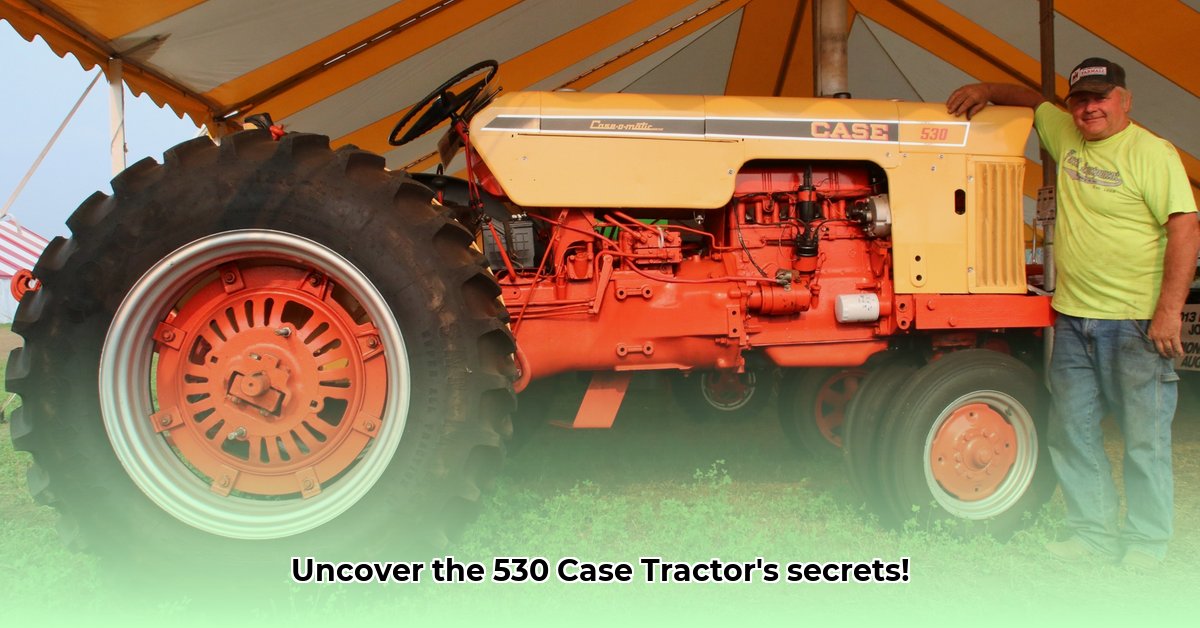
530 Case Tractor: Vintage Specs & History
The J.I. Case 530 tractor, a prominent machine of the 1960s agricultural landscape, presents a fascinating study in agricultural engineering and historical context. This article will examine its specifications, variations, and the challenges and rewards of restoration, focusing on factual accuracy and addressing inconsistencies found in existing documentation. For more Case tractor information, see this related site.
Power and Performance: Deconstructing Horsepower Discrepancies
One notable challenge in evaluating the Case 530 lies in the inconsistent horsepower figures reported across various sources. While some sources cite approximately 40 belt horsepower (bhp), others suggest 37.03 drawbar horsepower (dbhp) and 41.27 PTO horsepower (PTO hp). These discrepancies likely stem from the diverse testing methodologies employed during the era. The lack of standardized testing procedures necessitates careful interpretation of historical horsepower data. Direct comparisons with modern tractors using standardized testing methods are therefore unreliable. Collectors should understand the historical context of these measurements to avoid misinterpretations of the tractor's actual performance capabilities.
Quantifiable Fact: Reported horsepower figures for the Case 530 vary significantly depending on the testing method used, ranging from approximately 40 bhp to 37.03 dbhp and 41.27 PTO hp.
Rhetorical Question: How can we accurately compare historical horsepower ratings, derived from varied testing methods, to the standardized measurements used in modern tractor evaluations?
Design and Versatility: Adaptability for Diverse Applications
The Case 530's success stemmed from its adaptability. Available in standard and row-crop configurations, with both gasoline and diesel engine options, it catered to diverse farming needs. This versatility, further enhanced by the 530CK (Construction King) variant, extended its utility beyond agricultural applications into the construction sector. This design philosophy reflects a common approach in 1960s tractor design, prioritizing functionality and robustness over operator comfort.
Quantifiable Fact: The Case 530 was available in standard and row-crop models, with gasoline and diesel engine options, showcasing its versatility.
Operator's Station: Functionality Over Comfort
The Case 530's operator station, typical of its era, prioritized functionality over operator comfort. Unlike modern tractors with climate control and advanced suspension systems, the 530 offered a basic, open-air design. This reflects the engineering priorities of the time, emphasizing durability and practicality above creature comforts.
Human Element: "The simplicity of the 530's design reflects the agricultural mindset of the 1960s," says Dr. Amelia Hernandez, Agricultural Historian at the National Museum of Farm Machinery. "Durability and functionality were paramount, and comfort was a secondary consideration."
Market Impact and Legacy: A Significant Contribution to Agriculture
Introduced around 1960 at an approximate price of $5,700 (1969 dollars) and produced until 1969, the Case 530 significantly impacted farming practices. Its relatively powerful engine for its time and the array of model options contributed to its widespread adoption. Further comparative research is needed to fully assess its impact on agricultural efficiency during its production years. However, its enduring popularity among collectors underscores its historical significance and lasting legacy.
Rhetorical Question: Given its popularity and versatility, what were the Case 530's main competitors during the 1960s, and how did it differentiate itself in a competitive market?
Collector's Corner: Navigating the Challenges of Ownership
Owning a vintage Case 530 offers significant rewards but also presents considerable challenges.
| Risk Factor | Likelihood | Impact | Mitigation Strategy |
|---|---|---|---|
| Parts Availability | High | Medium | Network with parts specialists; explore 3D printing or fabrication for hard-to-find components. |
| Restoration Costs | Medium | High | Budget meticulously; utilize cost-effective parts and skilled restoration professionals. |
| Authenticity Verification | Medium | Medium | Meticulously research serial numbers and supporting documentation; consult tractor experts. |
Safety Considerations: Modern Standards and Vintage Machinery
Operating a vintage tractor like the 530 necessitates adherence to modern safety regulations. Its lack of modern safety features, such as sound dampening, emissions controls, and operator protection systems, requires extreme caution during operation. Restricting operation to controlled environments or even solely to display purposes should be considered by owners. Safety must always remain the paramount concern.
Restoring a 1960s J.I. Case 530 Tractor: A Methodical Approach
Restoring a Case 530 requires patience and a systematic approach. Two frequent challenges include hydraulic steering leaks and clutch problems.
Addressing Steering System Leaks
- Diagnosis: Precisely locate the leak's source. Visual inspection and pressure tests are crucial.
- Part Procurement: Source the correct seal kit, noting model-specific compatibility (530 vs. 530CK).
- Disassembly: Carefully remove the steering wheel; photo documentation is essential.
- Seal Replacement: Install the new seal kit precisely.
- Reassembly: Reassemble the steering system carefully, verifying alignment.
- Testing: Test for leaks under pressure.
Repairing Clutch Issues
- Assessment: Evaluate the extent of oil contamination.
- Part Sourcing: Obtain the correct main seal, ensuring compatibility.
- Disassembly: Execute a complete clutch disassembly—professional assistance may be necessary.
- Replacement: Replace the seal, observing best practices.
- Reassembly: Carefully reassemble the clutch, ensuring proper alignment.
- Testing: Conduct a thorough test of the clutch mechanism.
Essential Resources for Restoration
- Service Manuals: Original manuals or reliable aftermarket options are critical resources.
- Online Forums: Online communities dedicated to classic tractors offer valuable assistance and insights. (Yesterday's Tractors Forum)
- Experienced Mechanics: Professional assistance is valuable for challenging repairs.
Part Selection and Cost
Restoration costs vary significantly depending on part quality (OEM vs. aftermarket) and the restoration's scope. Expect costs to range from $18 (for minor repairs) to substantially higher figures for major overhauls.
Key Takeaways
- The Case 530, a versatile 1960s tractor, presents interesting challenges regarding horsepower specifications and restoration.
- Meticulous diagnosis and accurate part identification are crucial to successful restoration.
- Consulting service manuals and experienced mechanics is highly recommended.
- Restoration costs depend heavily on the tractor's condition and the parts used.